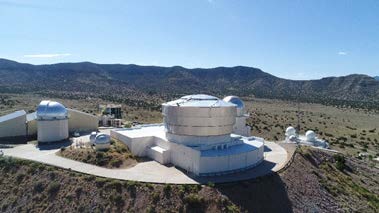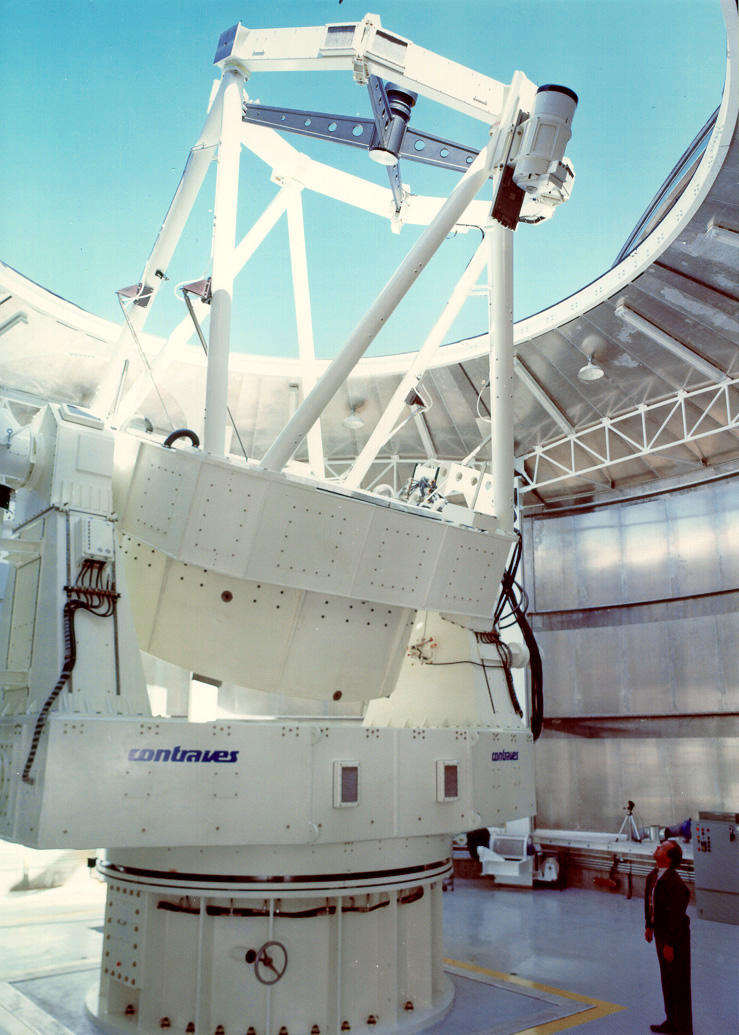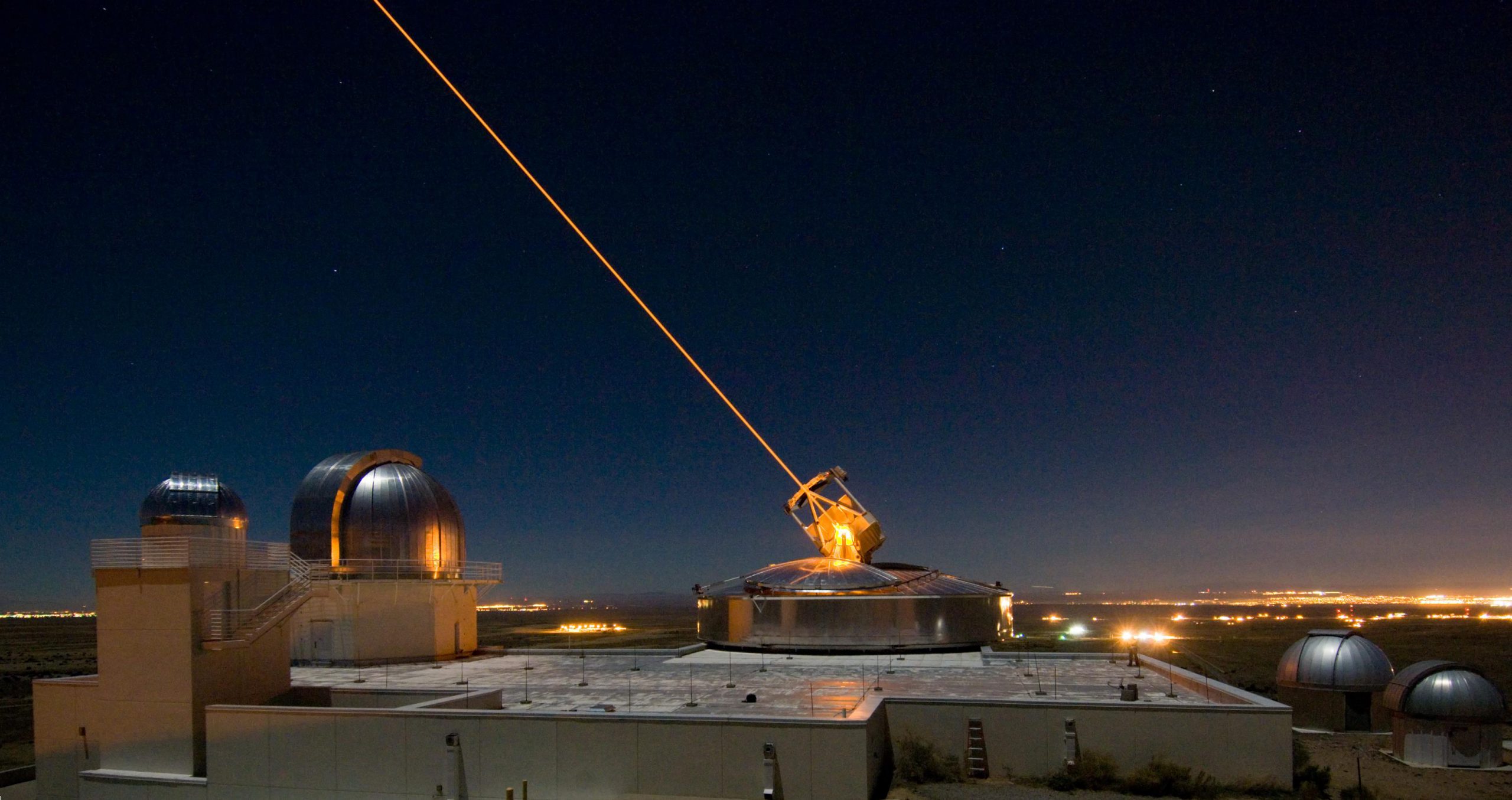STARFIRE OPTICAL RANGE
Space Domain Awareness
Freedom to maneuver in space is critical to meeting the United States Space Force and Air Force missions to fly, fight, and win in air, space, and cyberspace. The ability to exploit the characteristics of space gives the warfighter a competitive edge in virtually all engagements.
As satellites get smaller and the number of space objects increases, research in imaging and identification of space objects is paramount to meeting the Space Force’s mission.
To provide leadership in the area of space domain awareness, the Space Force conducts research and development in laser-beacon adaptive optics, beam control, and space object identification.

Aerial view of the Starfire Optical Range located on Mt. Fugate on Kirtland Air Force Base, N.M. (Photo/AFRL)
Facts about the Starfire Optical Range
- Located within AFRL’s Directed Energy Directorate on Kirtland AFB, N.M.
- Researchers are pioneers and leaders in the field of laser-beacon adaptive optics
- Houses the Department of Defense’s second largest telescope, the 3.5-meter telescope
- 3.5-meter telescope achieved first light on February 10, 1994 when it produced its initial image of a space object
About the Starfire Optical Range
As part of AFRL’s Directed Energy, Space Electro-Optics Division, the Starfire Optical Range (SOR) is a vital resource in achieving the Department of the Air Force’s mission to operate freely in space. This world-class research facility is located on a hilltop 1,900 meters (6,240 feet) above sea level on Kirtland Air Force Base, New Mexico. SOR’s primary mission is to develop optical sensing, imaging, and atmospheric compensation technologies to support aerospace missions.
This facility leads research into laser-beacon adaptive optics for military uses and civilian applications, such as astronomy. It is a major component of the Air Force Research Laboratory’s support to the U.S. Space Force.The SOR operates one of the world’s premier telescopes capable of tracking low-earth orbiting satellites. It has a 3.5-meter (11.5-feet) diameter primary mirror and is protected by a retracting cylindrical enclosure that allows the telescope to operate in the open air. Using adaptive optics, the telescope can distinguish basketball-sized objects at a distance of 1,600 kilometers (1,000 miles) into space.
In addition to the 3.5-meter telescope, the SOR includes four other optical mounts: a 1.5-meter telescope, two 1.0-meter telescopes, and a 1.0-meter laser beam director. All are capable of tracking low-earth orbit satellites and most are equipped with high performance adaptive optics systems and highly sensitive scientific cameras. Other instrumentation includes numerous small telescopes and beam directors, multiple laser systems, and several optics and electronics laboratories.
The Terry S. Duncan Space Technology and Research Laboratory (STARLab) is the main facility supporting the SOR mission. This facility includes extensive optics and electronics laboratories where equipment design, construction, and testing occur before integration with telescopes and other experiment hardware. The STARLab also houses a large mirror coating chamber for the periodic recoating of the SOR’s 3.5-meter primary mirror.
The SOR staff includes physicists, mathematicians, astronomers, electronic and mechanical engineers, optical designers and technicians, sensor and computer specialists, laser technicians, meteorologists, electricians, plumbers, welders, machinists, and other specialists.
3.5-Meter Telescope Details
The primary mirror of the 3.5-meter telescope was cast in a spinning furnace. With a lightweight, ‘honey-comb-sandwich’ primary mirror, this telescope weighs 2,000 kilograms (4,500 pounds) even though its glass face sheet is only 25-millimeter (1-inch) thick. When polished, the mirror surface has a tolerance of 21 nanometers, or 3,000 times thinner than a human hair. The mirror is supported by 56 computer-controlled actuators that allow shaping of the mirror.

The combined weight of the telescope, gimbals, optics, and support structures exceeds 100 tons. The telescope sits on a massive steel-reinforced concrete pier that weighs more than 700 tons. Isolated from the rest of the facility, the pier is anchored in bedrock with long steel rods.
(Photo/AFRL)
The telescope is located in a cylindrical enclosure that is often compared to a collapsible cup used by campers. This design has two major advantages over conventional domes, which are normally equipped with narrow slits: the enclosure itself does not have to rotate at high speed while satellite tracking and it improves image quality by not trapping warm air that could create optical distortions.

The sodium laser excites sodium atoms in the upper atmosphere to create a source of light or beacon 90 kilometers (55 miles) above the Earth. The adaptive optics system measures distortions of this beacon caused by atmospheric turbulence. The system then sends signals to actuators that alter the shape of a thin mirror thousands of times per second to compensate for atmospheric distortion of the image. (Photo/AFRL)
The protective enclosure was emulated when building a telescope on the SOR’s sister site in Maui, Hawaii. The Maui site, also part of the Space Electro-Optics Division within AFRL, houses telescopes similar to those found at the SOR, including the DoD’s largest telescope, a 3.6-meter (11.8-foot) telescope. The Maui research team conducts complementary experiments to those done at the SOR.

Using adaptive optics, images of objects outside the Earth’s atmosphere are much clearer as shown in these photos of Saturn. (Photo/AFRL)
Thermal control of SOR’s telescopes and facilities is essential to maintain the highest image quality. A unique feature of SOR’s facility is the removal of heat with a closed-cycle system where water is chilled by a large icehouse located 400 meters (¼ mile) from the telescope. The ice is stored in an underground pit for use during telescope operations. Unlike conventional air-conditioning systems, this method prevents heat from being released into the air near the telescope, which could make atmospheric distortions much worse. The 9-meter (30-foot) pit beneath the floor of the icehouse can hold 2 million kilograms (4.5 million pounds) of ice. The icehouse also contains gas-fired boilers, which can generate up to 2 billion joules (2 million BTUs) for hot water. By mixing the right proportions of hot and chilled water, very precise temperature controls can be achieved for the optical labs and equipment.
The SOR is widely recognized as one of the world’s leading laser-beacon adaptive optics and beam control research sites. With its research and field experiments in real-time atmospheric turbulence compensation and low-earth orbit satellite acquisition, pointing, and tracking, the Starfire Optical Range is truly a national asset.
